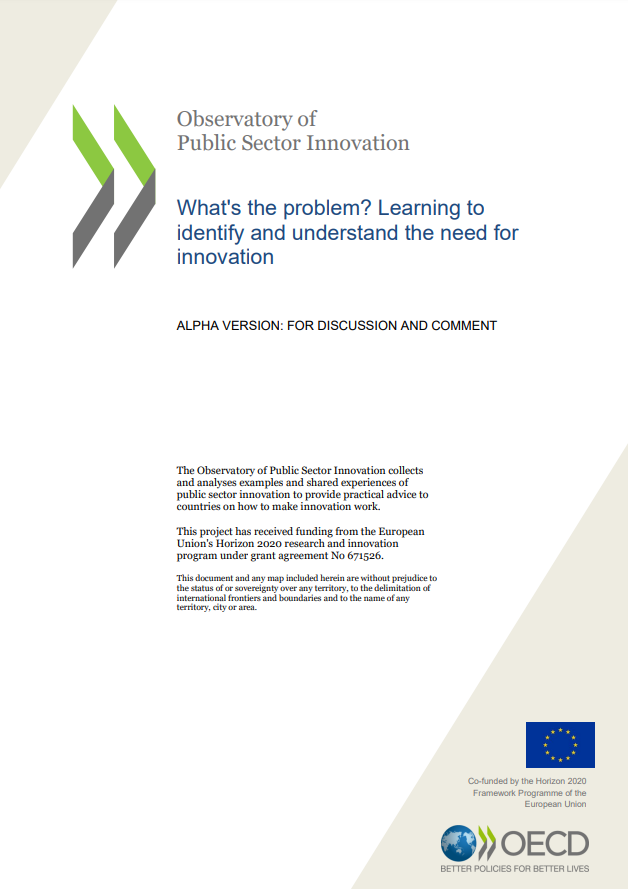What’s the problem? Learning to Identify and Understand the Need for Innovation (Innovation Lifecycle 1/6)

Summary
Public sector organisations are dealing with large and varied changes in their operating environment (see OECD 2015). Many traditional practices are no longer delivering the results that are expected or needed. There are pressures to perform, to meet changing expectations of government and to build trust that government can meet the needs of citizens. There is a need to lift productivity and effectiveness, and to work with citizens in new and more inclusive ways.
These pressures mean that public sector organisations will need to look to innovative approaches in order to meet the demands placed upon them. Organisations need to integrate innovation as part of their core activities. This means that they need to systematically put in place processes for the identification of problems, the generation of ideas, the formalisation of business cases, implementation of promising projects, evaluation and the diffusion of results. This process has been identified in the Innovation Lifecycle.
The importance of learning
The beginning of the innovation process is the identification of problems where an innovative response is required. If the reason for innovation is not clear, then the inevitable hurdles faced in introducing a new way of thinking or doing things will be much harder, and the other stages of the process much trickier than they need to be. i.e. if it is not clear what the problem being solved is, then assessing which new ideas will be useful will be hard, and effort could easily be wasted on exploring ideas that will not thrive.
Effectively identifying problems relies on learning – learning what is not working, what might be possible, or what might be potential problems.
Learning is also a fundamental part of the overall innovation process. The learning process ensures that innovation is tailored to an organisation’s needs and context and is adapted across an organisation and its ecosystem. Innovation without learning is luck, and governments cannot rely on luck or chance to answer citizen expectations.
A changing context
Public sector organisations have always had to learn (and the public sector has a long history of innovating) however there are two issues which suggest that particular attention needs to be given to learning for innovation:
- Learning completely new things is different and more difficult than learning things that are already well understood. Innovation is an uncertain and exploratory process, and involves different considerations than learning about existing things, where the process is better understood.
- Public sector organisations are operating in a context of constant new information which makes the scale and scope of learning needed very different from the world in which public services evolved.
Effective learning for innovation
An appreciation of the different features of learning for innovation provides a suggested framework for organisations and individuals, revolving around three cascading factors:
- Enabling Conditions: What are the enabling conditions that encourage organisations and individuals to reflect and allow people to challenge existing ways of thinking?
- Channels for Learning: What are the channels for learning? How is new intelligence about the world and the changing operating context accessed?
- Tools: What are the tools that can be used to reveal current assumptions? That can best demonstrated the difference between ‘what is’ and ‘what is wanted’, and provide insight into how to respond to that gap?
Enabling conditions
Organisations can maximise their learning for innovation by giving consideration to a number of enabling factors, grouped around:
- Purpose – having a clear understanding of what the organisation is trying to achieve
- Openness – being open to different perspectives
- Capacity – having the capacity to absorb and integrate learning from outside of the organisation
- Capability – having the ability to act and build on the new things that are learnt
- X-Factor – recognising that each organisation is different, and will need to assess their own context and learning for innovation needs
With the right environment for learning for innovation, organisations will be better placed to understand and recognise problems when they emerge.
Channels for learning
Organisations will also need to ensure that they are connected with, and are learning from, the constant source stream of new information and knowledge being generated in the world.
Organisations can do this by considering the different channels by which relevant information reaches the organisation:
- Where is the organisation currently learning from?
- Which channels provide the most surprises or unexpected learning?
- Are there any big gaps in these channels for learning?
- Do any of these channels allow the organisation to challenge existing knowledge, and to potentially encourage it to ‘unlearn’ fundamental assumptions or investment in the status quo?
- The right mix of channels can ensure that organisations are receiving the intelligence they need to identify problems early on.
Tools
A number of tools can also assist with the process of identifying and learning about problems, and how to begin to respond. A number of tools are proposed, based on their ability to meet or contribute to some or all of the following features:
- Clarifying intent
- Making assumptions explicit and building shared understanding
- Avoiding jumping to conclusions
- Connecting with others
- Experimentation and reducing the cost of failing
- Reframing the problem
These can be considered at the level of the organisation, its leaders and its employees. A series of prompting questions to enable self-assessment or reflection about learning for innovation have been developed and are provided in Appendix 1.

What’s the problem? Learning to Identify and Understand the Need for Innovation
Published on 3 October 2016.
